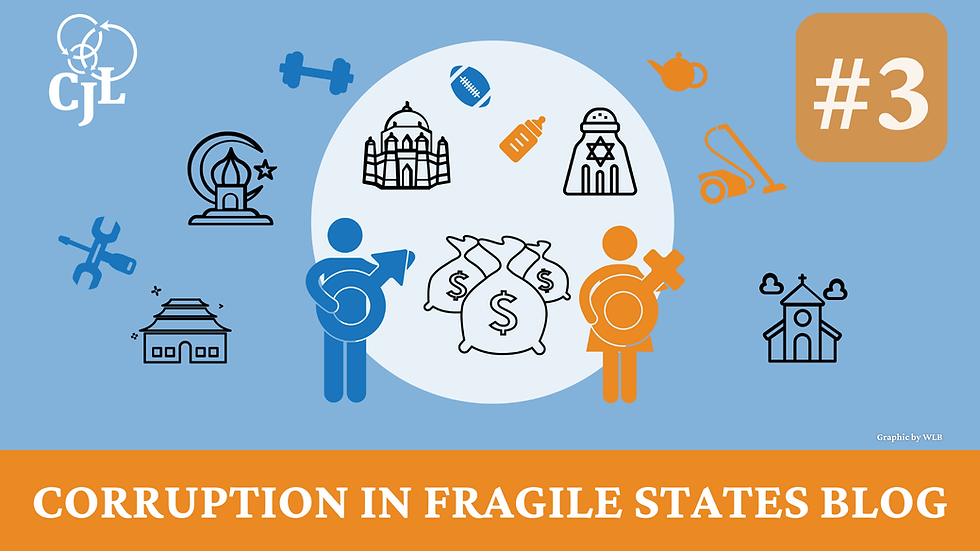By Diana Chigas, Co-Director, CJL

Do gender norms make women less corrupt, and do religious norms make members of religious communities less corrupt?
Following on from the two earlier blogs in our series on gender and faith, and the evidence from our research to date, the answer seems to be yes—and no. Gender norms and religious norms can counteract pressures to engage in corrupt behaviors. But equally, they can reinforce social norms that drive corruption, or block anti-corruption action.
Why should we care about how multiple identities influence norms driving corruption?
First, the answers can help us develop effective strategies to combat the inequality, discrimination, exclusion and marginalization that are caused and perpetuated by corruption. Second, they can enhance the effectiveness of anti-corruption strategies working with social norms. For example, understanding the intersectional aspects of norms can help us understand when, how, and under what conditions faith-based actors can be effective anti-corruption advocates. Or how to best support and expand ‘islands of integrity’ comprised primarily of women without reinforcing harmful gender stereotypes.
What our research has shown
What have we learnt about gender and faith norms either exacerbating or mitigating pressure to engage in corrupt acts? And what does the existing evidence suggest for how practitioners should diagnose social norms and design anti-corruption social norms programming?
We scanned the literature from 2013–2023 to identify articles on gender and religion/faith and their interaction with social norms influencing corruption in service delivery. As noted in the earlier blogs, we found only 139 relevant publications in the academic and grey literature, and only 45 specifically focused on norms. Though scant, the evidence did support our own experience that gender and religion can influence whether, when, and how people engage in corrupt behaviors.
While there is still much to understand, I gained several useful insights for practitioners to consider.
My three practical takeaways for anti-corruption social norms programming
1. Unpack the ‘who’ as well as the ‘what’.
We have said this before, and we’ll say it again (and again): being concrete and specific is key to designing programs that catalyze behavior change. This means it is important to identify clearly what specific corrupt behavior(s) we are talking about, who is doing them and what groups hold in place the different norms affecting the behavior. This is even more important when looking at the intersections of gender and faith norms with corruption-related social norms—as the norm interactions can affect every part of a corrupt practice. For example, they can determine:
Whether a female doctor refrains from charging a patient for drugs and services that should be free while her male counterpart does not, or whether her religion stops her from behaving corruptly;
Whether an expectant mother seeking services will feel pressured to offer to pay a bribe in one situation (e.g., getting medical services for her children), but not in another (e.g., getting an identity document from a government official);
Whether and how much a female doctor will be sanctioned if she is caught or if she reports corruption—in comparison to men; or
Whether someone will report the corruption (or not), and who will or will not do so.
Gender, faith and other identity group norms also affect how people of different identities are treated in and experience corrupt transactions. The variety of contexts and patterns of competing norms mean that we need to be very clear about what the specific behavior is and who is engaging in it.
"Gender norms and religious norms can counteract pressures to engage in corrupt behaviors. But equally, they can reinforce social norms that drive corruption, or block anti-corruption action."
2. Know how the same norms may influence people differently—depending on the context and the person’s role in the corrupt act.
‘Where you stand depends on where you sit.’ For me, this saying (sometimes attributed to Nelson Mandela) captures well the complexity of the interaction of gender and other identity-based norms with corruption-related norms. The role someone is playing in the corrupt transaction can determine how gender, religious or other norms affect their response to corruption-promoting social norms.
For example, gender norms prescribing particular roles to men and women may make social expectations to ‘fulfill one’s gendered role no matter what’ apply less to female service providers but more to female service seekers, especially when they are accessing services related to household responsibilities. Consequently, gender norms may make it easier for a woman to resist pressure to demand or accept bribes in her role as judge or doctor but increase pressure on her to offer bribes when seeking healthcare or educational services.
3. Understand how people manage conflicting norms within their groups.
Social norms literature tells us that when a person is faced with multiple (and possibly conflicting) expectations, the norms of the most salient group will prevail. Our findings from the literature review for gender and religious norms chime with this. For example, female judges may more easily resist expectations among judges to use their position of power to ‘eat’, or ‘to feed’ their family, because this gender norm is less salient for women than it is for men in that situation. Similarly, in this same context among judges, injunctive religious norms against corruption among adherents of the same faith may prevail only when the norm in the religious group is strong enough (above the 30th percentile) to be more salient than the norms mandating judges to demand bribes.
Engaging with the complexity
But what if the contradictory norms are not between different groups but within one group? The literature suggests this happens frequently—at least regarding gender and faith norms. Women, for example, are expected to be ‘purer’ and less corruptible than men. At the same time, they are under social pressure to do what it takes to fulfill the expectations of their gendered role—including engaging in corrupt practices or staying silent when they observe or experience corruption, even sextortion. So they are constantly balancing these opposing pressures.
Religious norms carry similar mixed messages—and pressures. Nearly all religions condemn various forms of corruption and mandate integrity. Yet people are expected to contribute financially to their religious community and are also more accepting of corrupt practices if the proceeds benefit their religious community. In some religious practices, they are even rewarded socially and religiously for accumulating wealth, which is seen as a favor of God. As with gender norms, people need to figure out how to manage the tension between these conflicting religious norms.
We don’t know how to assess the varying influences of norms in these situations – but the literature hints that these tensions are not resolved through a simple process of determining ‘salience.’ We have seen that women find covert means for engaging in corrupt behaviors to resolve the competing pressures gender norms place on them. This suggests that we need to look beyond salience to understand how people manage and rationalize tensions between norms when several contradictory norms related to the same identity are simultaneously salient.
What’s next?
The literature offers some useful hypotheses to consider as we probe these relationships, but there are still many unknowns. What’s clear is that it is not straightforward; there is no ‘one’ way that gender or religious norms interact with social norms driving corrupt practices. There is no tidy ‘formula’ or ‘checklist’ for analyzing or integrating insights around norm interactions into programming.
Stay tuned as we as embark on our own research effort in partnership with the Policy Innovation Centre (PIC) in Nigeria and develop and test a methodology for diagnosing and integrating knowledge about these intersections into program design.
This blog series is made possible with support from the MacArthur Foundation.

Diana is a Co-Director at The Corruption, Justice and Legitimacy Program. She is the Senior International Officer and Associate Provost at Tufts University and a Professor of the Practice of International Negotiation and Conflict Resolution at the Fletcher School of Law and Diplomacy. She has worked with governmental and non-governmental organizations on systemic conflict analysis, and strategic planning, reflection and evaluation to improve the impact of peace programming.
Diana has over 25 years of experience as a facilitator and consultant in negotiation and conflict resolution, as well as an advisor and evaluator of social change programming in conflict-affected countries, including in the Balkans, East Africa, South Africa, El Salvador, and Cyprus, as well as with organizations such as the OSCE and the United Nations. Diana has received her JD from Harvard Law School and MALD from the Fletcher School at Tufts University.


